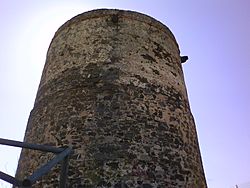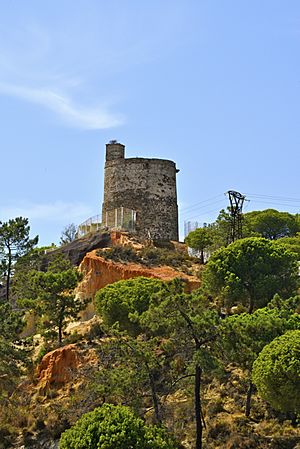Torre del Catalán facts for kids
Quick facts for kids Torre del Catalán |
|
|---|---|

Torre del Catalán, seen from its base.
|
|
| General information | |
| Status | Bien de Interés Cultural |
| Type | Military building |
| Location | Lookout on a cliff |
| Town or city | |
| Country | |
| Coordinates | 37°12′59″N 7°11′51″W / 37.216392°N 7.197514°W |
| Completed | 1596 |
| Owner | Lepe city council |
| Height | 9.8 m |
| Technical details | |
| Material | Stone and brick |
The Torre del Catalán (which means 'Catalan Tower' in English) is an old watchtower in Lepe, Huelva province, Spain. It's a special building, officially called a Bien de Interés Cultural. This tower stands on a tall hill near the coast, between La Antilla beach and El Terrón port. Its main job was to watch for pirates and protect the coastline. From the tower, you can see the beautiful Marismas del río Piedras y Flecha del Rompido nature area.
Contents
What is the Torre del Catalán?
What's in a Name?
Today, everyone calls it the Torre del Catalán. But for a long time, until the 1700s, its official name was Torre de Sierra Bermeja. The name Sierra Bermeja comes from the reddish color of the hill where the tower stands. Bermejo means reddish or auburn. However, old records from the 1500s show that people already used the name El Catalán for this area.
How Did the Tower Work?
The Watchtower was home to one or more lookouts. Their job was to scan the sea for Barbary pirates. These pirates often tried to attack the coast. If they spotted danger, the lookouts would send signals. At night, they used fire. During the day, they used smoke or waved white cloths.
Many other watchtowers were built along the coast of Huelva. Some are gone, some are restored, and one even turned upside down after an earthquake! This was the Torre de la Higuera. Before these towers were built, castles in inland villages like Lepe protected the coast.
What Does the Tower Look Like?
The tower is 37 meters (about 121 feet) above sea level. It is 2.4 kilometers (1.5 miles) from El Terrón Port. It is also 1.22 kilometers (0.76 miles) from the shore.
The tower has a frustum shape, like a cone with its top cut off. It is built with brickwork and rough masonry. You can see a step halfway up the tower. This step shows where the two different building phases meet. The bottom part is solid stone. The top part is made of stone and brick.
The main entrance door is 4.93 meters (about 16 feet) above the ground. It has a flat top, called a lintel. This high entrance kept the tower guards safe from direct attacks. People used a rope or a wooden ladder to get in. They would pull it up once inside. The entrance opening is 1.35 meters (4.4 feet) tall and 0.57 meters (1.9 feet) wide. It faces the ground and is made of limestone.
Inside, there's a small entrance hall called a zaguan. It's rectangular and goes through the 2.05-meter (6.7-foot) thick wall. A curved arch covers it. From this hall, stairs lead up to the roof. These stairs have sixteen steps. They curve with the wall, instead of being a spiral staircase.
The main room of the tower is round, with a diameter of 4.60 meters (15 feet). It has a dome-shaped ceiling made of brick. On the floor of this room, there's an opening for a well.
The top of the tower is a terrace, 7.10 meters (23 feet) wide inside. A low wall, called a parapet, surrounds it. This wall does not have battlements for cannons. Three gargoyles stick out from under the parapet. They help drain rainwater away. There's also a small, square room on the roof. This room covers the top of the stairs. It has a false dome made of flat stones. This room is quite large, 2.80 meters (9.2 feet) tall, 1.80 meters (5.9 feet) wide, and 1.63 meters (5.3 feet) deep. Its size makes it a key part of the tower's look.
History of the Torre del Catalán
Why Was the Tower Built?
The building of the Torre del Catalán was part of a big plan by King Philip II of Spain. He wanted to defend the coast from Barbary pirates. In the 1500s, after the discovery of America, trade with the Indies grew. This led to more pirate attacks on Spain's Atlantic coast.
Between 1570 and 1576, officials checked the coast and suggested building these watchtowers. In 1577, a royal order came to build a watchtower in Sierra Bermeja. Local leaders agreed but didn't want to pay. They felt it helped the city of Seville more than them. Other nobles also refused to pay.
In 1584, the Crown sent a lawyer to make nobles pay for the towers. Then, in 1587, Drake's expedition in the Bay of Cádiz made everyone speed up the building. Records show the Torre del Catalán was already 5.60 meters (18.4 feet) tall by June 1587.
The work stopped for a few years. In 1590, a court order forced the nobles to pay. The tower was finally finished by June 13, 1597. You can still see the two building phases. A brick line separates them, and the top part is a bit narrower.
In 1618, it was planned that three soldiers would guard the tower. It didn't have cannons. Cannons were likely at the Torre de El Terrón, closer to the Piedras River. The town of Lepe was responsible for helping defend the coast with the Torre del Catalán and El Terrón.
When Did the Tower Decline?
In the 1700s, the watchtower started to become less important. This was mainly because the sea moved away from its cliff. The estuary at its base filled with sand. The terrible 1755 Lisbon earthquake made things worse. It destroyed many houses in Lepe and left the tower a kilometer (0.6 miles) from the shore.
In 1720, three people still worked at the tower. In 1739, there was a plan to add two cannons, but this never happened. Even after the earthquake, in 1756, the tower was still in use. It had a captain in charge. It kept appearing on maps as Torre del Catalán. However, by 1820, most watchtowers, including this one, were no longer used. The nearby Torre de El Terrón was ruined by 1820 and gone by 1900. This made the Torre del Catalán the most important building on that part of the coast.
What is the Tower Like Today?
The Torre del Catalán was protected by law in 1949. This law protected all Spanish castles. It was officially listed as a "Bien de Interés Cultural" (a site of cultural interest) in 1985. In 1993, it was added to the Andalusian Catalog of Cultural Interest.
In 2015, the tower was part of a special program. This program let people visit and learn about old fortresses. The city council of Lepe bought the tower and the land around it in 2015. They paid about €39,000. In 2019, they made a deal with Endesa to rent more land nearby. The goal is to create a center around the tower. This center will teach visitors about the history and defense buildings of the area.
See also
 In Spanish: Torre del Catalán para niños
In Spanish: Torre del Catalán para niños


